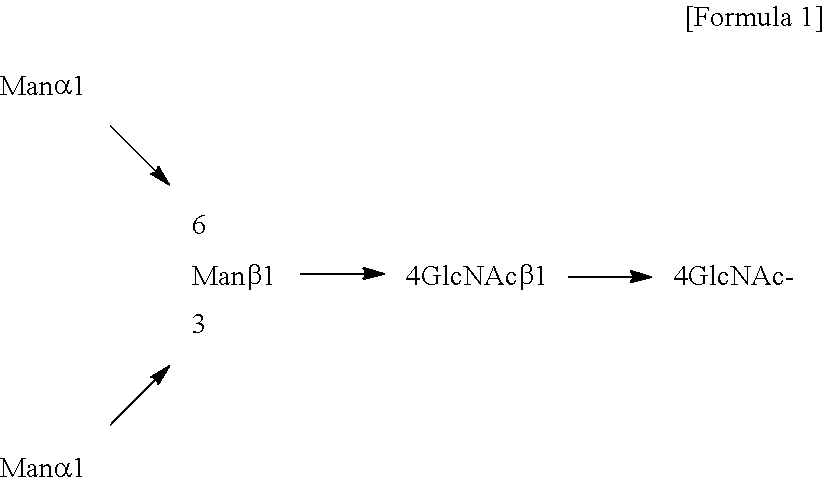Method for Detecting Glycoprotein
- Summary
- Abstract
- Description
- Claims
- Application Information
AI Technical Summary
Benefits of technology
Problems solved by technology
Method used
Image
Examples
examples
[0074]Hereinafter, the present invention will be described in more detail with reference to Examples of the present invention. However, the present invention is not limited to the following Examples.
[0075]The reagents for use in the present invention were prepared as shown below.
(1) Buffer Solution
[Phosphate Buffered Saline (PBS)]
[0076]5.75 g of disodium hydrogenphosphate (from Wako Pure Chemical Corp.), 1.0 g of potassium dihydrogenphosphate (from Wako Pure Chemical Corp.), 1.0 g of potassium chloride (from Wako Pure Chemical Corp.) and 40.0 g of sodium chloride (from Wako Pure Chemical Corp.) were weighed, and the volume was further increased to 5 L with water. The resulting solution was to be phosphate buffered saline (PBS).
[0.05% Tween / PBS]
[0077]2.5 mL of polyoxyethylene (20) sorbitan monolaurate (trade name: Tween 20, from Nacalai Tesque Co., Ltd.) was dissolved in 51, of PBS to obtain a PBS solution of 0.05% Tween 20 (hereinafter referred to as 0.05% Tween / PBS).
[1 M glycine-Hy...
examples 1 to 14
[Examples 1 to 14] Detection of Pepsin-Treated AFP-L3 by Lectin Having Affinity with Fucose, Sialic Acid, Galactose, Mannose, Glucose Etc. (I)
[0116]A glycoprotein AFP-L3 was pepsin-treated for 30 minutes, and the resulting pepsin-treated AFP-L3 was detected by the lectin ELISA (sandwich method). In the detection test, the same manipulations as in the above-described sandwich ELISA method except for the followings:
[0117]For (1) Antibody immobilization, an anti-human AFP monoclonal antibody (mouse) (from Funakoshi Co., Ltd.) was used as the solidified antibody;
[0118]For (5) Antigen-antibody reaction, a pepsin-treated AFP-L3 (5,000 ng / mL) and an untreated AFP-L3 (5,000 ng / mL) were used as the glycoprotein solution;
[0119]For (7) Lectin reaction, the biotin-labeled lectins described in Table 1 were used, and an anti-AFP antibody (from Wako Japan) at 1 μg / mL was used instead of lectins;
[0120]For (9) HRP-labeled streptavidin reaction, when the anti-AFP antibody was used instead of lectins ...
examples 15 to 21
[Examples 15 to 21] Detection of Pepsin-Treated AFP by Lectin Having Affinity with Sialic Acid, Galactose, Mannose, Glucose Etc
[0123]A glycoprotein AFP was pepsin-treated for 30 minutes, and the resulting pepsin-treated AFP was detected by the lectin ELISA (sandwich method). The detection test was carried out with the same procedure as that of Examples 7 to 13 and Comparative Example 1 except for replacing the glycoprotein AFP-L3 by AF. The reaction values (S-N) with respect to each of the lectins and the increase amount Δ of the pepsin-treated AFP and the untreated AFP are shown in Table 2.
TABLE 2Lectin / antibodyConcen-IncreasetrationReaction value (S-N)amountName(μg / mL)(S-N)np(S-N)pΔExample 15ConA100.3060.5390.233Example 16SNA-I10.0090.0750.066Example 17SSA100.0180.2510.233Example 18RCA12010.1760.4320.256Example 19ECA100.0310.0520.021Example 20PHA-E4100.0430.4280.385Example 21MCL100.0120.0310.019ComparativeAnti-AFP11.2121.052−0.160Example 2antibody
[0124]With reference to Table 2, i...
PUM
| Property | Measurement | Unit |
|---|---|---|
| Fraction | aaaaa | aaaaa |
| Fraction | aaaaa | aaaaa |
| Density | aaaaa | aaaaa |
Abstract
Description
Claims
Application Information
 Login to View More
Login to View More - R&D
- Intellectual Property
- Life Sciences
- Materials
- Tech Scout
- Unparalleled Data Quality
- Higher Quality Content
- 60% Fewer Hallucinations
Browse by: Latest US Patents, China's latest patents, Technical Efficacy Thesaurus, Application Domain, Technology Topic, Popular Technical Reports.
© 2025 PatSnap. All rights reserved.Legal|Privacy policy|Modern Slavery Act Transparency Statement|Sitemap|About US| Contact US: help@patsnap.com

